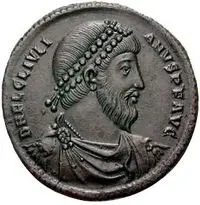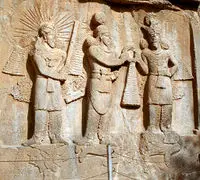What were the reasons for the defeat of the Emperor Julian the Apostate's invasion of Persia in 363 AD
Contents
Introduction
Emperor Julian (331-363 AD), often known as Julian the Apostate was one of the most important Emperors in the history of the Later Roman Empire. He was the last non-Christian to reign as Emperor. Julian wanted to halt the Christianization of the Empire and revoked many of the rights of the Church. The Emperor was an able man, a gifted administrator, and soldier. It seemed that he would change the Roman Empire, but his disastrous invasion of Sassanian Persia was to end all his ambitions. His defeat virtually ensured that Christianity would triumph in the Roman Empire.This article will discuss the reasons for the failure of the Emperor’s invasion of Persia. It will outline how the invasion was overambitious and that poor strategic decisions resulted in the Emperor’s defeat and his death.
Background
Julian was a member of the Constantinian dynasty and a descendant of Constantine the Great. He was one of the few male members of his family who survived a massacre that was ordered by Constantinus III. Later while still a young man he was promoted to the rank of Caesar. In 355 AD he inflicted a series of defeats on the Alamanni and Franks tribes. Most notable was his victory over a confederation of German tribes in 357 A.D. at the Battle of Argentoratum. He later after the death of Constantius III became the sole emperor of the Roman Empire. Unlike the other members of the Constantinian dynasty, he was a pagan. Julian was a philosopher, and under the influence of Neo-Platonist philosophy, he began to revere the Olympian Gods. He was brought up a Christian, but he believed that this religion was undermining the traditional Roman values’, and this was weakening the Empire [1]. After assuming the purple, he marginalized the Christian Church and favored pagans, for example he restored many temples. Julian was careful not to persecute the Christians as he knew that previous persecutions had only strengthened that religion. The Christians hated him. Julian championed the ancient religion of Rome and Greece in a series of polemics. In his work Against the Galileans, he claims Christianity was a series of falsehoods. In one section of the work he claims ‘’ I was convinced that the fabrication of the Christians is a fiction of men composed by wickedness’ [2]. There is some evidence that his efforts to promote paganism did have some impact. The Emperor also favored the Jews. However, the Christians remained as powerful as ever, despite the change in Imperial policy. Some argue that Julian did not want to destroy Christianity but wanted ultimately to see some the fusion of the Christian faith with the pagan polytheistic religion. Julian was a great administrator and he reformed the court, bureaucracy and granted more powers and privileges to the cities[3]. In 363 AD the Emperor decided to launch a massive invasion of Persia. Many argue that there were sound strategic reasons for the proposed invasion. Persia under the Sassanian dynasty was a powerful enemy and had secured the strategic initiative on Rome’s Eastern Frontier. The pagan sources such as Ammianus, state that Julian invaded Persia to conquer the Persian Empire[4]. It is almost certain that Julian wanted to occupy large parts of Persia or to turn it into a puppet regime, as he brought a claimant to the Sassanian throne with him during his invasion. The second motive for Julian’s invasion was to emulate the achievement of Alexander the Great. The Emperor main goal was to re-establish the Roman religion as Emperor. Julian’s invasion of the Persian territories could be interpreted as an attempt to secure a victory that would persuade the Romans’ to return to their old gods and ways and abandon Christianity.
Invasion of Persia
The Emperor Julian’s army with his Armenian allies invaded the Sassanian Empire in 363 A.D. This was the last major invasion of the Persian Empire by Rome. Julian prepared meticulously for the invasion of the Sassanian realms. He re-organized the legions of the East and turned them into formidable fighting units. Julian also brought with him experienced legionnaires from the west. Julian establish a flotilla of ships to carry his legions deep into Persian territory and to supply his forces[5]. This was an innovative strategy. Julian conducted the early stages of the invasion very impressively. He had asked his ally Armenia to concentrate a large force on their mountainous border with Persia. This had convinced many in Persia that Rome would invade via the highlands of Armenia. Many previous Roman armies had followed this route. In this terrain, the Roman legionnaires had the advantage over the formidable Persian cavalry, especially the famed horse archers. In a daring move, Julian invaded through the Syrian desert and followed the route of the Euphrates River. The Persian Shah Shapur II had been deceived by Julian and was unprepared for the invasion. Julian dispatched a decoy force under Procopius into Persian territory to further confuse Shapur II and his court. Julian’s forces advanced rapidly, and he forced the Sassanian king to retreat. The transport fleet allowed a large body of troops to be provisioned. Julian feigned a march towards the Tigris, hoping to draw into a battle. At this time, he divided his forces and a large army under Procopius invaded Mesopotamia. Upon reaching Carrhae, the main Roman force under Julian turned south and rejoined the transport fleet to begin the main invasion and its goal was to capture of the Sasanian winter capital of Ctesiphon [6]. If Julian captured the city, he would have shown that paganism had restored Rome to greatness. It would also force the Sassanian Shah to the east and ensure that he could not attack the Roman frontier. Julian defeated a large Persian army on the outskirts of the city of Ctesiphon and he besieged it. However, he failed to take the city and quietly abandoned the siege and he burned his flotilla of ships and marched to meet up with the army of Procopius. Many argue that he should have retreated to Syria and abandoned Procopius, but Julian was an honorable man. He joined up with the other army and they made their way north to reach Armenia. The Persians constantly harried the Romans and inflicted heavy casualties [7]. It appeared that Julian’s army the largest possibly ever assembled, for an invasion of Persia was about to be destroyed. The two armies clashed at Samarra now in Northern Iraq, but the battle was inconclusive. However, Julian was wounded, and he died three days later. His successor Jovian saved the army with a dishonorable peace, and the new Emperor had to pay tribute to the Persians. Julian’s polices that favored paganism were quietly abandoned and within decades paganism was outlawed by Emperor Theodosius the Great.
Flawed Planning
At first it appeared that Julian was waging a brilliant campaign and he was undoubtedly a talented strategist. Julian failed to appreciate the level of resistance as he advanced on Ctesiphon. This was a critical mistake and resulted in Julian losing the initiative. The resistance on the route to Ctesiphon allowed the Persian Shah, Shapur II to gather his forces and to assemble a large army. The other great mistake, was that Julian had divided his forces, a basic and unforgiveable error. He ordered Procopius to advance into Mesopotamia, but this achieved little and only weakened his own army. After the failure to take the winter-capital of the Persians, Julian instead of retreating to safety in Syria had to rescue the army of Procopius [8]. If Procopius forces had been with the main force, Julian could have forced a retreated down the Euphrates with his fleet of ships in support. Instead the Emperor was obliged to move towards the Tigris, right into the heart of Persia. It was during this effort to contact Procopius that the Battle of Samarra took place. In this Julian was wounded and he later died of his wounds. This ultimately led to his army becoming stranded in Persian territory. Furthermore, Julian did not have the technical capability to engage in a length siege of the Sassanian capital. There were very few siege engines with the army, such as a battering ram or a ballista. Ammianus, in his histories asserts that Julian hoped that an overwhelming show of force would persuade Ctesiphon to surrenderCite error: Closing </ref> missing for <ref> tag. Julian’s plans for the invasion of Persia and his campaign objectives were based on unrealistic assumptions and a fundamental misunderstanding of that Empire. Rome had been in decline and no longer had the resources it once had. The Romans had failed to conquer Persia, even when it was stronger under the great Emperor Trajan in the second century AD. Julian did not seem to understand that his Empire was no longer the force that it once was and that his grandiose schemes were unrealistic and even delusional.
Superstition of Julian
It is agreed in the pagan and the Christian sources that in the planning of the invasion of Persia, Julian did not take the counsel of his generals. It seemed that the Emperor was never willing to take advice and he trusted his own judgments. Julian was praised by the Panegyrist Liberanus for not ‘holding council with his generals but with the gods’ [9]. This would indicate that Julian was more interested in omens and portents than his generals, practical advice. It is recorded that the Emperor visited a shrine and received some omens which he did not share with anyone in Syria before the invasion. The reference by Liberanus may also indicate that Julian saw the invasion in a religious and mystical light and was too readily guided by his religious beliefs rather than by the reality on the ground. Julian was very religious’ and he may has believed that he was divinely favored. This is very much conveyed in his writings when he constantly referred to his guiding spirit[10]. The religious beliefs of Julian may explain some of his grievous mistakes as they appear to have clouded his judgment.
Conclusion
Julian’s handling of the invasion of Persian was disastrous. He had unrealistic ambitions and objectives and his planning was not based on the practical challenges involved. He was possibly too eager to achieve a spectacular victory to revive traditional religions and this may have led him to make basic mistakes. Julian made several strategic decisions that undermined his invasion. The Emperor failed to predict that extent of the resistance the Euphrates route to Ctesiphon and unbelievably he failed to prepare for a siege of Ctesiphon. Then he had divided his forces, which was contrary to military doctrine at the time and since. After the failure of his siege of Ctesiphon, Julian was obliged to link up with the force of Procopius and this led not only to his death but also left the Roman army in a precarious strategic position. Julian’s handling of the invasion was poor This resulted in Julian making several miscalculations that probably meant that his defeat in Persia was inevitable. The disaster in Persia in 363 AD. was to ensure that Christianity’s rise in the Roman Empire was unstoppable.
References
- ↑ Grant, Michael. The Roman Emperors (New York: Barnes and Noble Books, 1997), p. 254
- ↑ Julian, "Against the Galileans", 143
- ↑ Grant, p. 255
- ↑ Ammianus, Histories, v.11
- ↑ Tougher, Shaun. Julian the Apostate. Edinburg, Edinburgh University Press. 2007), p. 27
- ↑ Tougher, p. 113
- ↑ Murdoch, Adrian, The Last Pagan (UK: Sutton Publishing Limited, 2003), p. 113
- ↑ Murdoch, p. 118
- ↑ Libanius, Oration 18, 306
- ↑ Grant p. 118


